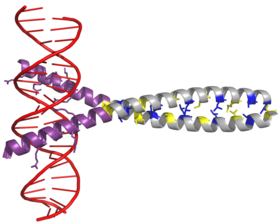AP-1 transcription factor

| AP-1 Proteins (Fos, ATF, JDP) | |
|---|---|
| Identifiers | |
| Symbol | AP-1 |
| InterPro | IPR000837 |
| Transcription factor Jun | |
|---|---|
| Identifiers | |
| Symbol | Leuzip_Jun |
| InterPro | IPR002112 |
Activator protein 1 (AP-1) is a
History
AP-1 was first discovered as a TPA-activated transcription factor that bound to a
Structure
AP-1 transcription factor is assembled through the dimerization of a characteristic
The basic region of the bZIP domain is just upstream to the leucine zipper, and contains positively charged residues. This region interacts with DNA target sites.[9] Apart from the “leucine zipper” and the “basic region” which are important for dimerization and DNA-binding, the c-jun protein contains three short regions, which consist of clusters of negatively charged amino acids in its N-terminal half that are important for transcriptional activation in vivo.[10]
Dimerization happens between the products of the c-jun and c-fos protooncogenes, and is required for DNA-binding. Jun proteins can form both homo and heterodimers and therefore are capable of binding to DNA by themselves. However, Fos proteins do not dimerize with each other and therefore can only bind to DNA when bound with Jun.[11][12] The Jun-Fos heterodimer is more stable and has higher DNA-binding activity than Jun homodimers.
Function
AP-1 transcription factor has been shown to have a hand in a wide range of cellular processes, including
Cell growth, proliferation and senescence
The AP-1 transcription factor has been shown to play numerous roles in cell growth and proliferation. In particular, c-Fos and c-Jun seem to be major players in these processes. C-jun has been shown to be essential for
Cellular senescence has been identified as "a dynamic and reversible process regulated by (in)activation of a predetermined enhancer landscape controlled by the pioneer transcription factor AP-1", which "defines the organizational principles of the transcription factor network that drives the transcriptional programme of senescent cells".[15][16]
Cellular differentiation
AP-1 transcription is deeply involved in the modulation of
Apoptosis
AP-1 transcription factor is associated with a broad range of apoptosis related interactions. AP-1 activity is induced by numerous extracellular matrix and genotoxic agents, suggesting involvement in programmed cell death.[2] Many of these stimuli activate the c-Jun N-terminal kinases (JNKs) leading to the phosphorylation of Jun proteins and enhanced transcriptional activity of AP-1 dependent genes.[2] Increases in the levels of Jun and Fos proteins and JNK activity have been reported in scenarios in which cells undergo apoptosis. For example, inactivated c-Jun-ER cells show a normal morphology, while c-Jun-ER activated cells have been shown to be apoptotic.[19]
Regulation of AP-1
Increased AP-1 levels lead to increased transactivation of target gene expression. Regulation of AP-1 activity is therefore critical for cell function and occurs through specific interactions controlled by dimer-composition, transcriptional and post-translational events, and interaction with accessory proteins.[20]
AP-1 functions are heavily dependent on the specific Fos and Jun subunits contributing to AP-1 dimers.[10] The outcome of AP-1 activation is dependent on the complex combinatorial patterns of AP-1 component dimers.[2] The AP-1 complex binds to a palindromic DNA motif (5’-TGA G/C TCA-3’) to regulate gene expression, but specificity is dependent on the dimer composition of the bZIP subunit.[2]
Physiological relevance
AP-1 transcription factor has been shown to be involved in skin physiology, specifically in tissue regeneration. The process of skin metabolism is initiated by signals that trigger undifferentiated proliferative cells to undergo cell differentiation. Therefore, activity of AP-1 subunits in response to extracellular signals may be modified under conditions where the balance of keratinocyte proliferation and differentiation has to be rapidly and temporally altered.[21] The AP-1 transcription factor also has been shown to be involved in breast cancer cell growth through multiple mechanisms, including regulation of cyclin D1, E2F factors and their target genes. c-Jun, which is one of the AP-1 subunits, regulates the growth of breast cancer cells. Activated c-Jun is predominantly expressed at the invasive front in breast cancer and is associated with proliferation of breast cells.[22] Due to the AP-1 regulatory functions in cancer cells, AP-1 modulation is studied as a potential strategy for cancer prevention and therapy.[23][24][25]
Regulome
See also
- Activator protein
- Transcription factor
References
- PMID 15564374.
- ^ PMID 14585541.
- S2CID 4314423.
- S2CID 23154076.
- PMID 11402330.
- PMID 3289117.
- PMID 2911757.
- PMID 2503872.
- PMID 2166997.
- ^ PMID 1751545.
- S2CID 4355663.
- S2CID 11057487.
- PMID 9069263.
- S2CID 90318354.
- S2CID 220071911.
- S2CID 219543898.
- S2CID 34337538.
- PMID 36697417.
- PMID 9130714.
- PMID 19167516.
- PMID 11402337.
- PMID 17637753.
- S2CID 35328722.
- S2CID 20160666.
- PMID 26918517.
- PMID 7835696.
- PMID 11823475.
- S2CID 4329320.
- PMID 16000406.
- PMID 16670084.
- PMID 8164647.
- ^ PMID 16357172.
- PMID 11514621.
- S2CID 18150052.
- ^ PMID 15602048.
- S2CID 22605840.
- S2CID 25556684.
- PMID 17220278.
- PMID 18370921.
- S2CID 30654477.
- PMID 16709830.
- PMID 10479648.
- PMID 18384814.
- PMID 9950682.
- PMID 17003107.
- PMID 16131569.
- S2CID 25127065.
- S2CID 25446228.
- PMID 9651209.
- S2CID 37036603.
- PMID 10330050.
- PMID 15833113.
- ^ PMID 9854051.
- PMID 17065199.
- PMID 11440364.
- PMID 11535421.
- PMID 9643353.
- ^ Suetsugu M, Takano A, Nagai A, Takeshita A, Hirose K, Matsumoto K, et al. (2007). "Retinoic acid inhibits serum-stimulated activator protein-1 via suppression of c-fos and c-jun gene expressions during the vitamin-induced differentiation of mouse osteoblastic cell line MC3T3-E1 cells" (PDF). J. Meikai Dent. Med. 36 (1): 42–50.
- PMID 12397041.
- PMID 10211966.
- PMID 15494506.
- PMID 10559258.
- PMID 7646547.
- PMID 11314000.
- PMID 16306573.
- PMID 18227166.
- PMID 17043106.
- PMID 15319452.
- PMID 12915550.
- PMID 12060604.
- PMID 8928842.
- PMID 24741667.
- PMID 18201367.
- ^ Uniprot Database
- PMID 32104530.


